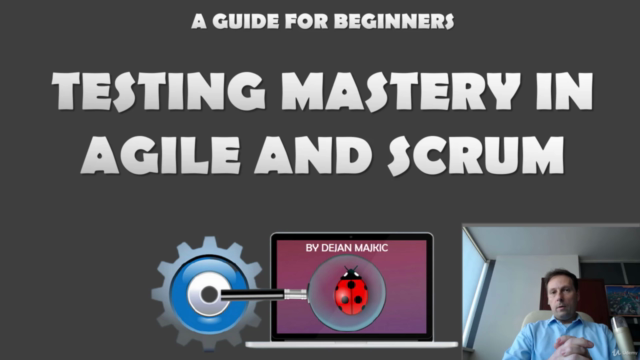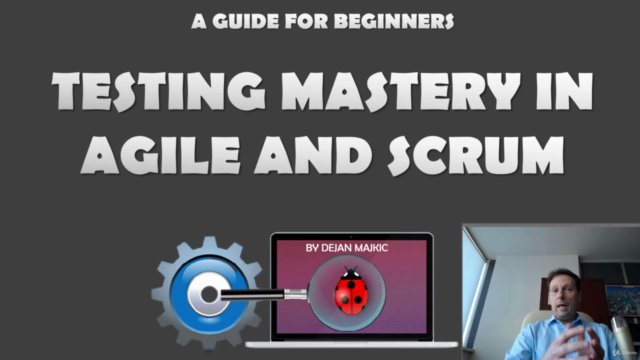Scrum Testing: Learn Testing in Agile and Scrum from A to Z

Why take this course?
您提到了很多与Scrum相关的关键词和短语,这些都是在实际应用Scrum框架时可能会遇到或需要理解的概念。下面我将尝试回答您之前提出的问题,并提供一些关于如何在现实生活中应用Scrum的例子和建议。
Barriers to successful agile adoption by test teams:
- Resistance to Change: Test teams may be accustomed to traditional waterfall models and resistant to the iterative nature of Agile.
- Lack of Understanding: A lack of understanding of Agile principles and practices can lead to incorrect implementation or hesitation to adopt an Agile mindset.
- Cultural Shift: Organizational culture may not support collaboration, continuous feedback, or the empowerment of team members, which are key to Agile practices.
- Resource Constraints: Test teams may be understaffed or lack the necessary tools and environment to conduct effective Agile testing.
- Inadequate Training: Team members might not have received adequate training in Agile methodologies, leaving them uncertain about their roles and responsibilities.
- Complex Legacy Systems: Existing complex legacy systems can make it difficult to implement Agile practices effectively due to technical debt and architecture constraints.
- Poor Communication: Ineffective communication between cross-functional teams can lead to misunderstandings, delays, and defects.
- Inflexible Management: Management may expect strict adherence to processes and timelines that are not compatible with the flexible nature of Agile.
- Unclear Requirements: Ambiguous or changing requirements can make it difficult for testers to create effective test cases and plans.
- Testing Toolkit: Test teams need a robust toolkit that supports automated testing, continuous integration, and deployment practices inherent in Agile. Tools like Jenkins, Selenium, JUnit, and Cucumber can be part of this toolkit.
How to successfully apply Scrum in test teams:
- Embrace Agile Principles: Ensure that the team understands and embraces the core principles of Agile, such as customer collaboration over contract negotiation, responding to change over following a plan.
- Cross-functional Teams: Create mixed teams with developers, testers, and UX designers who can work closely together throughout the development lifecycle.
- Continuous Training and Coaching: Provide ongoing training for team members to develop their Agile skills, including understanding Scrum terminology, artifacts, and ceremonies.
- Automated Testing: Encourage the adoption of automated testing practices early in the development cycle to ensure faster feedback cycles.
- Collaborative Work Environment: Foster a culture of collaboration and transparency where team members can share progress, challenges, and feedback openly.
- Agile Tools: Utilize Agile project management tools like Jira, Trello, or Azure DevOps to track progress, manage backlogs, and facilitate collaboration.
- Sprint Retrospectives: Regularly reflect on the Sprints' outcomes and identify ways to improve the testing process within the Scrum framework.
- Define Clear Test Cases and Criteria: Establish clear criteria for acceptance testing and ensure that they are understood by both developers and testers.
- Risk Assessment: Incorporate risk assessment into the planning stage of each Sprint to address potential issues early on.
- Empowered Scrum Master: The Scrum Master should facilitate Agile adoption, remove impediments, and help the team follow Scrum practices effectively.
Scrum Framework Overview:
- Roles: Product Owner, Scrum Master, Development Team.
- Artifacts: Product Backlog, Sprint Backlog, Increment.
- Events/Ceremonies: Sprint Planning, Daily Stand-up, Sprint Review, and Sprint Retrospective.
- Values: Commitment, Courage, Focus, Openness, and Respect.
Scrum of Scrums: This is a scaling event used to address the complexities in large Scrum organizations or multiple Scrum teams working on the same product. It allows teams to coordinate their work, share impediments, and communicate progress at a higher level without over-burdening any single team.
Scrum Master Interview Questions:
- Can you describe how you facilitate Scrum ceremonies in your current/previous role?
- How do you handle conflicts within the team or with external stakeholders during the Sprint cycle?
- What strategies do you use to remove impediments effectively?
- Can you provide an example of how you've helped a team improve their agile practices?
- How do you ensure that the Development Team adheres to the Scrum framework without stifling creativity or innovation?
Scrum Master Certification Cost: The cost can vary depending on the certification provider. Organizations like Scrum Alliance (Certified ScrumMaster®) and International Scrum Institute ( Professional ScrumMaster™) offer certification with different pricing structures.
Scrum Master Responsibilities: Facilitate Scrum events, support the Development Team in performing at their highest level, remove impediments to the team’s progress, and ensure that all Scrum processes are followed. The Scrum Master is a servant-leader for and across Scrum Teams.
Define Scrum: Scrum is a framework within which people can address complex adaptive problems, while productively and creatively delivering products of the highest possible value. It is composed of Scrum roles, ceremonies, artifacts, and rules.
希望这些信息能帮助您更好地理解如何在现实世界中将Scrum应用于测试团队,并克服可能遇到的障碍。如果您有更具体的问题或需要进一步的指导,请随时提问。
Course Gallery




Loading charts...